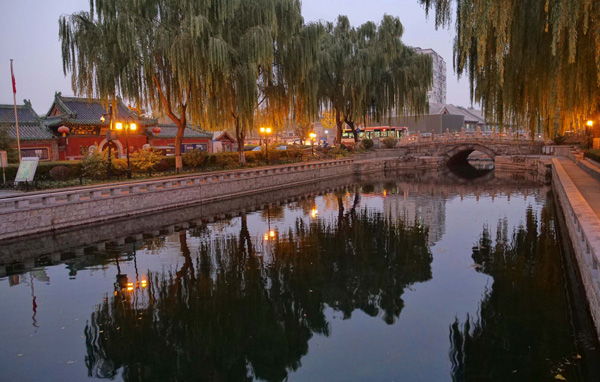
by successfulbob | Guest Post, Lumix G9, travel photography
China Through the Eyes of Ken MacAdams – Part Two
We continue Ken’s story from last Friday. Check out Part One here.
Forbidden City
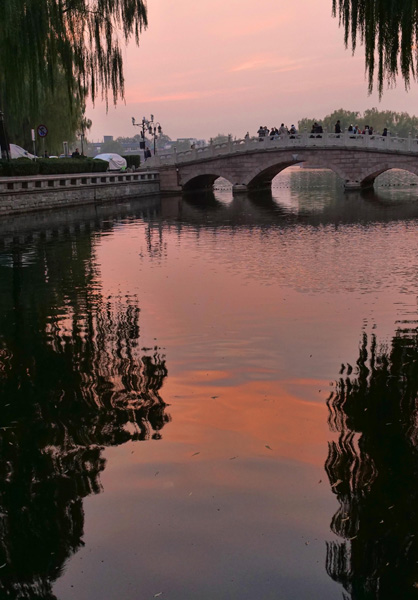 This lake is in a barrio outside the Forbidden City. The smog aids in coloration at sunset by diffusing the light. Many walk the pathways by the lake.
This lake is in a barrio outside the Forbidden City. The smog aids in coloration at sunset by diffusing the light. Many walk the pathways by the lake. All Photos in this post © Ken MacAdams 2018 All Rights Reserved
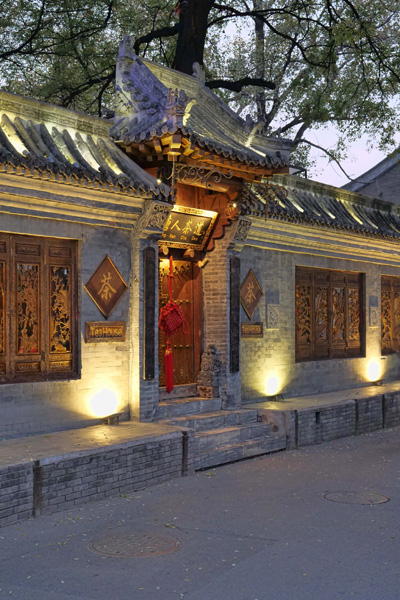 The Chinese take their tea seriously – and to be invited to a tea ceremony is a wonderful experience!
The Chinese take their tea seriously – and to be invited to a tea ceremony is a wonderful experience! When we returned to Beijing, we walked down to the Forbidden City. Once the residence of the Emperor, and strictly off limits to the public, this treasure has been opened up to the public in recent years. It’s a walled city within itself, complete with a moat surrounding it. Within the walls, the Emperor, his wives, concubines, and children all had their appointed places. Only dignitaries or men on official business would be allowed into the great hall just inside the gate, where they could transact business with the Emperor. To facilitate trade from without the city, the Emperor had a canal dug, of which part is still accessible today.
 The Grand Canal and ancient bridge dating back to 1154 A.D.
The Grand Canal and ancient bridge dating back to 1154 A.D. A little Beijing Info
About 1100 A.D. Beijing became the new capital of China, and has remained so until today. The original city wall and gate, along with many other old historic landmarks were destroyed during Chairman Mao’s Cultural Revolution. Today, the city’s population approaches the 30 million mark, and high-rise business and apartment buildings stretch as far as the eye can see. Smog presents an issue here as the government struggles to clean up the old smokestack industries. The mass of automobiles often overpowers the capacities of the highway system and long traffic jams are the norm at morning and evening rush hour. Public buses, taxi’s, and subways do their part to move the masses, and many resort to electric bicycles and scooters as a means of short haul commuting.
Even though we’d been busy hitting the streets, the effects of jet-lag was beginning to set in. We welcomed the quiet of our hotel room as the door clicked closed behind us. A good rest would help us move on to our next destination, the the adventures ahead.
Ken has always loved to travel, so when he made a common connection with the fact that either a long day pounding the streets of some foreign city, or shooting the last dance at a wedding, a good part of his physical

weariness came from lugging around his big heavy DSLR. That’s when he started looking at alternatives – and ended up selecting Panasonic Lumix Micro Four Thirds gear.
Ken is rarely without a camera, and the next great photo travel experience – whether local or abroad – is always in the back of his mind! A longtime resident of the Four Corners, and when he’s not out on the road, he enjoys some of the great outdoor opportunities found there – mountain biking, hiking, and Jeeping.

by successfulbob | Guest Post, Marketing Monday, photography
Portrait Pricing Guidelines – Marketing Monday
with Steve Bedell
This article is from EPhoto Newsletter, a free bi-weekly newsletter for professional photographers. To subscribe for more great info contact Steve at [email protected].
Pricing
If you’re like me, you belong to more than a couple of Facebook photography groups. At the end I’ll even list some that I feel are the most valuable.
Reading the posts in these groups is both an education and a frustration. The same questions posted over and over, and then 68 responses from people who may or may not be qualified, but they’re going to chime in anyway.
With that in mind, that brings us to part one: what should your prices be?
I find it hard to believe that people just go on these groups and ask prices like, ‘Hey, how much should I be charging for an 8×10?’ More surprisingly, people will answer something like ‘I charge $45’ or ‘I charge $195’. Wrong answer.
But perhaps my favorite is ‘First, you need to figure your Cost of Doing Business (CODB).’ It used to be that no one took the time to do a few tedious calculations to figure that out and while I can applaud the fact that more people are aware that you actually have to have some kind of idea of what your numbers need to be?
I find it hard to believe that people just go on these groups and ask prices like, ‘Hey, how much should I be charging for an 8×10?’ More surprisingly, people will answer something like ‘I charge $45’ or ‘I charge $195’. Wrong answer.
But perhaps my favorite is ‘First, you need to figure your Cost of Doing Business (CODB).’ It used to be that no one took the time to do a few tedious calculations to figure that out and while I can applaud the fact that more people are aware that you actually have to have some kind of idea of what your numbers need to be in order for you to generate the income you desire, that is NOT the FIRST question you should be asking yourself.

Mistake one: The first question should be ‘Where do I want to position myself in the market?’
You see, all that other stuff is fine but how can you set prices until you define your market and your brand. Do you want to sell unique 30×40 painted portraits for $20,000? Do you want to do school photos for $25 a unit? Do you want to sell prints or files or both? Are you seeing why it makes no sense to figure out COGS and CODB until you define your niche in the market?
You see, all that other stuff is fine but how can you set prices until you define your market and your brand. Do you want to sell unique 30×40 painted portraits for $20,000? Do you want to do school photos for $25 a unit? Do you want to sell prints or files or both? Are you seeing why it makes no sense to figure out COGS and CODB until you define your niche in the market?
With that taken care of, let’s go ahead and address some other pricing issues that make my head boil every time I see them.
Mistake number 2: Starting out at a low price to get business and raising it later.
Big mistake. Later won’t ever come unless you move to another city and start with new clients because you’ve already branded yourself at a certain price level. Work for FREE until you feel your work commands the price you want and then start charging. It’s far harder to dig out of a hole than to start out where you want to be. If you need to do another job or earn income some other way, do it.
Mistake number 3: Selling files, or selling files and prints.
OK, I expect some will disagree with me here but hear me out. I know MANY successful photographers who make a great living selling wall prints and other print products. While there are probably some, I don’t know any who make a great living selling files.
Here is the part I don’t understand. If we sell artwork, we can command a decent price for it. And we can sell many copies of it. I had a client a couple of years ago for an extended family portrait session. She bought $4500 worth of 5×7’s! And I ran into her at the beach one night while I was doing a family portrait and she was there with some family members in beach clothes and she asked if I could take photos of them when I was done with my family. I said sure. She ordered another $2200 worth of 5×7’s from those super casual beach photos!
That’s almost $7000 worth of 5×7’s from 2 files. Imagine if I sold that file for $300. I’d have $600 instead of $6700. How much more work would I have to do to sell files to make that amount? What if I gave them the file with each print they ordered, like some photographers do? I’d still be WAY under!
More from Steve next Monday!
Steve Bedell has been a professional photographer for over 35 years. He has done weddings, portrait and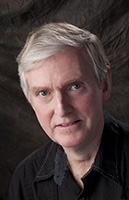 commercial work but now restricts his business to portraits only.
Steve holds the Master of Photography and Photographic Craftsman degrees from the Professional Photographers of America and is a PPA Approved Print Juror.
commercial work but now restricts his business to portraits only.
Steve holds the Master of Photography and Photographic Craftsman degrees from the Professional Photographers of America and is a PPA Approved Print Juror.
He has been named the New Hampshire Photographer of the Year a record 8 times and in 2011 was awarded the New England Photographer of the Year title. His specialty is natural light portraiture.
He has written hundreds of articles for photo publications, taught classes and workshops nationwide and produced several lighting DVDs. His private newsletter, EPhoto, reaches over 2000 photographers. Steve was a regular contributor to Shutterbug magazine.
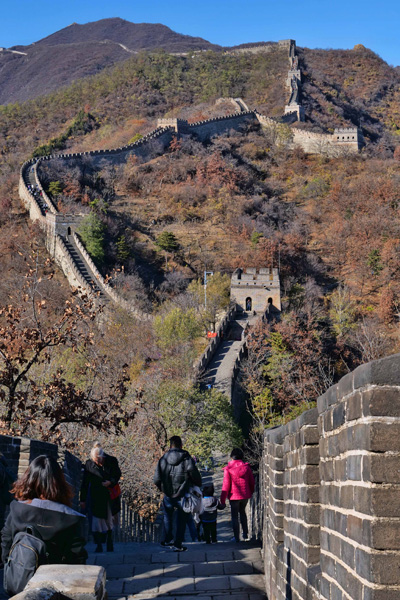
by successfulbob | architectural photography, Guest Post, Lumix G9, travel photography
China through the Eyes of Ken MacAdams – Part One
Ken is currently wending his way through China and shares news and images from his travels here on Succssful-Photographer.
The 12 + hour flight to China will tweek your psychological time clock, not matter how you cut it. We welcomed deplaning in Beijing, and getting our feet back on the ground. Flying from the USA, we’d crossed the International Date Line, so lost a day. After breezing through immigration, we stepped out into the terminal, into the face of new smells and sights. Like the reality of the time difference, once you step off the gateway, you know you’re not in Kansas.
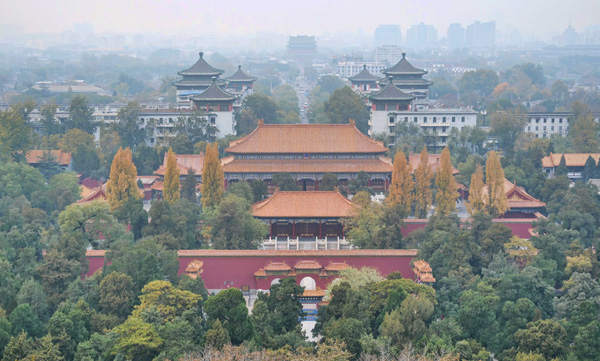
Forbidden City gate with the modern city in the background. Smog is often present – and many people wear face masks when walking about. All Images in this post © Ken MacAdams 2018 All Rights Reserved
Personal Photography Project
This marks my 5th sojourn in China, and each visit is an enriching experience. My visits now are part of a personal photography project, in which I’m documenting the tremendous changes going on in this vast land. China has often been ‘off limits’ to foreigners, and in recent times it wasn’t until the late 1980’s that foreigners could obtain visas to travel here. My first visit was in 2000. Already changes were happening as the ‘New China’ came out from under the repression of the Cultural Revolution – an era that almost put China back into the Dark Ages.
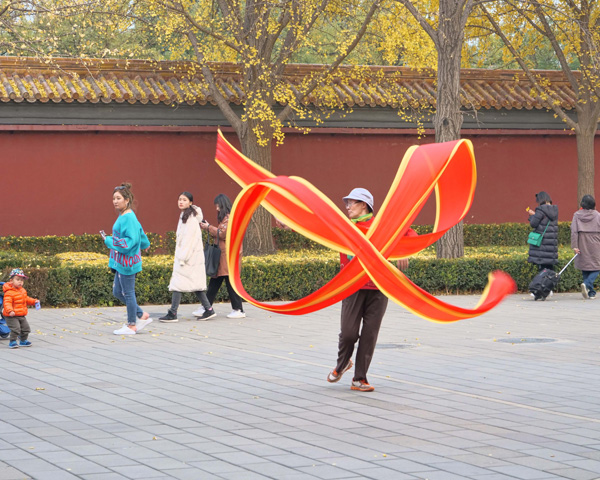 Woman dancing to music with a banner flag in one of the many parks.
Woman dancing to music with a banner flag in one of the many parks.We’d planned only a short sojourn in Beijing, but wanted to experience a different section of the Great Wall, and see some of the changes around the city since our first visit here. A teacher I’d met last year picked us up at the airport and shuttled us to a motel near his apartment. Foreigners must stay only at State approved hotels, as Big Brother keeps a close eye on affairs here. I’m not intimidated by it, just aware that as I travel about, my every move is documented and tracked. My wife is with me, and we’re here on 10 year multiple entry tourist visas, with a maximum stay of 60 days per visit.
 Hiking on the Great Wall from one watchtower looking back down the mountainside.
Hiking on the Great Wall from one watchtower looking back down the mountainside. This view of the Wall gives you a perspective of just how much hiking you have ahead of you!!
This view of the Wall gives you a perspective of just how much hiking you have ahead of you!! The Great Wall
Our friend had arranged for a driver to shuttle us out to the Matianyu section of the Wall. Luck presented us with one of the sunniest days I’ve ever experienced in this area, with brilliant blue cloudless skies. This section of the Wall climbs over 3,400 ft. as it clings to the spine of the rugged mountains. A modern gondola whisked us part way up the mountainside, and then it was time to hike! We logged over 3 miles of semi-strenuous hiking during our visit, poking around watchtowers, savoring the grand vistas, and marveling at the thought of those who labored so hard to build this Wonder of the World. Originally constructed to prevent fierce raiding tribesmen from the north from plundering the city states to the south, the wall stretches from the Pacific Ocean to the east, several thousand miles inland.
Ken has always loved to travel, so when he made a common connection with the fact that either a long day pounding the streets of some foreign city, or shooting the last dance at a wedding, a good part of his physical

weariness came from lugging around his big heavy DSLR. That’s when he started looking at alternatives – and ended up selecting Panasonic Lumix Micro Four Thirds gear.
Ken is rarely without a camera, and the next great photo travel experience – whether local or abroad – is always in the back of his mind! A longtime resident of the Four Corners, and when he’s not out on the road, he enjoys some of the great outdoor opportunities found there – mountain biking, hiking, and Jeeping.
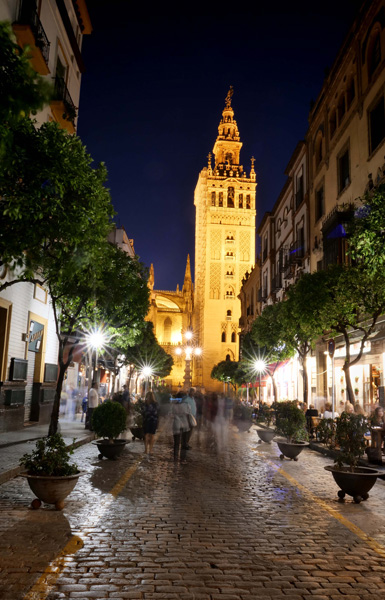
by successfulbob | architectural photography, Guest Post, Lumix G9, travel photography
Seville, Spain – Travel with Ken MacAdams Part Three
A few blocks away from the Alcazar is the Hospital de la Caridad, a 17th-century charity hospital which served as a place of final refuge for Sevilla’s poor and homeless. The hospice and hospital were founded in 1626 by Don Miguel Manara, a one-time playboy who in later life had a change of heart and spent his last years dedicating his life to strict worship and taking care of the poor.
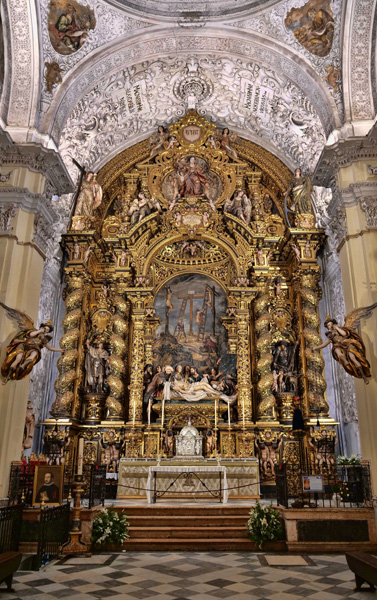 This was the “small” chapel at the Hospital de la Caridad. Statues, period artwork, and Dutch tile scenes graced the courtyards of the hospital.
This was the “small” chapel at the Hospital de la Caridad. Statues, period artwork, and Dutch tile scenes graced the courtyards of the hospital.
Inside you’ll find Italian statues (his wealthy family was from Italy) and Dutch tiles from Delft, depicting scenes from the Old and New Testament, a reminder that the Netherlands was under Spanish rule in centuries past.
Walk a few crooked blocks, and you’ll find yourself at the Plaza de Toros, or the bullfighting ring and museum. Guided tours take you through the empty arena, its museum, and the chapel where the matadors pray before the fight. Bullfighting still takes place here from May to September. Novice bullfighters take the ring on Thursday evenings in July. Serious bullfighters, the professionals, fight on special events and holidays, and these events often sell out in advance.
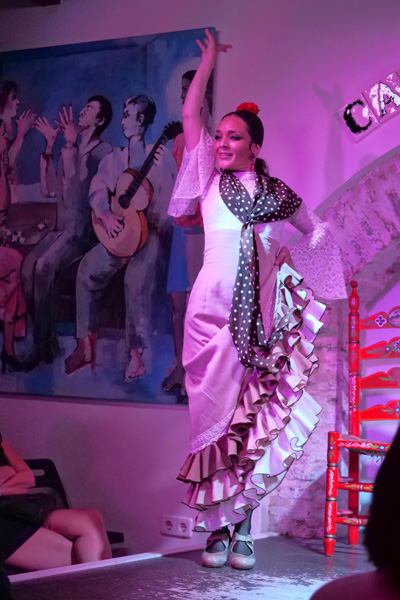
A handheld (no tripods allowed) shot of a Flamengo dancer at a sold-out performance along one of the back streets in the Jewish Quarter, adjacent to the Alcazar area.
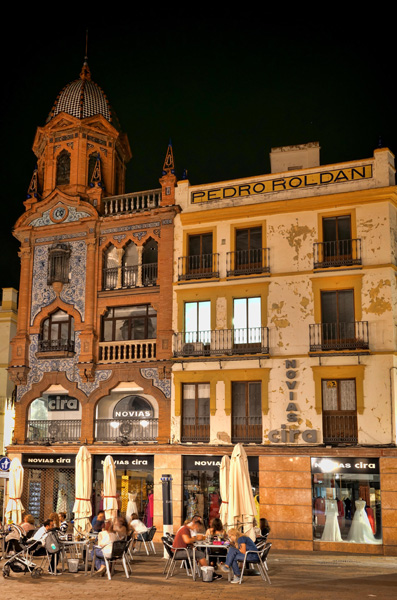
A typical street cafe and tapas bar scene. Note the inlaid tile work on the building on the left.
Flamenco, the dance that embodies the spirit of southern Spain, can be found in numerous locations and barrios nightly. Some of the establishments offer flamenco lessons, while others house exhibits of flamenco costumes and other artifacts.
A part of any visit to Seville is sampling the cuisine. Some feel the time spent sitting at an outdoor street cafe, savoring tapas and a bottle of wine, is as important as visiting the great city sights! Tapas are small portions of seafood, salads, meat-filled pastries, and other delicious bites. Tapas bars can be found in all areas of the city, and every local has their favorite!

Twenty-five-second nighttime exposure of the Giralda Bell Tower, a stunning landmark of Sevilla.
Oozing with Old World Charm, Seville is a destination in Spain not to be missed. Allow two days to see the main sights, and linger longer if possible! When you’re finished, head on to Andalucia’s White Hill Towns for your next over-the-top Spanish experience!
Ken has always loved to travel, so when he made a common connection with the fact that either a long day pounding the streets of some foreign city, or shooting the last dance at a wedding, a good part of his physical

weariness came from lugging around his big heavy DSLR. That’s when he started looking at alternatives – and ended up selecting Panasonic Lumix Micro Four Thirds gear.
Ken is rarely without a camera, and the next great photo travel experience – whether local or abroad – is always in the back of his mind! A longtime resident of the Four Corners, and when he’s not out on the road, he enjoys some of the great outdoor opportunities found there – mountain biking, hiking, and Jeeping.
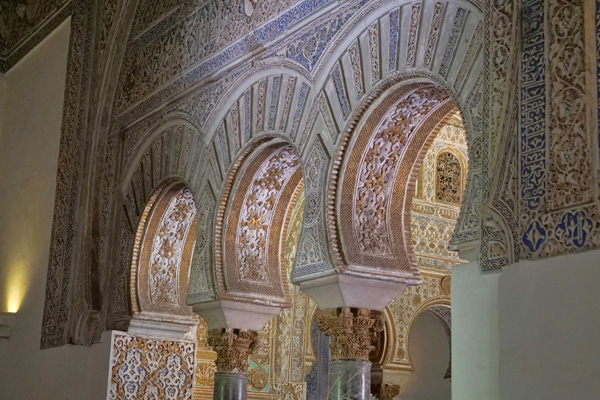
by successfulbob | architectural photography, Guest Post, Lumix G9, travel photography
Seville, Spain – Travel with Ken MacAdams Part Two
No visit to Seville is complete without a visit to the Royal Alcazar. Originally a 10th-century palace for the governors of the local Moorish state, this is Europe’s oldest still in use palace. Rebuilt in the 14th century by the Christian king Pedro I (by Muslim workmen), it features spectacularly decorated halls, courtyards, and gardens.
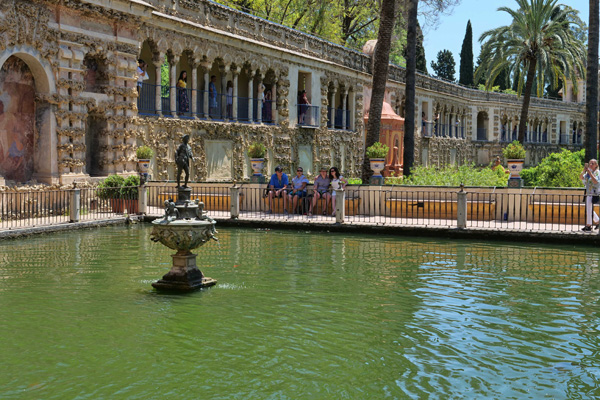
In the Garden Pool was a small statue of Mercury. This pool was fed by a 16th-century aqueduct.
There are distinctive Islamic-style flourishes seen in the archways, walls, and ceilings. As you enter, you’ll pass a rough stone wall, remnants of an older Moorish fortress, circa A.D. 913.
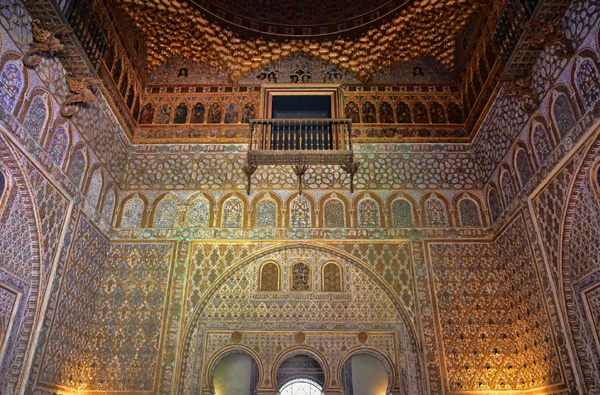
This image shows the painstaking attention to detail recorded on the walls and ceiling of the Hall of Ambassadors. All photos in this post © Ken MacAdams
In the Admiral’s Hall, Columbus recounted his travels, and Ferdinand Magellan planned his around-the-world venture. Queen Isabella realized Columbus’s New World discoveries could be big business. Here resides a model of Columbus’ flagship, the Santa Maria. In the center of King Pedro’s palace is the Courtyard of the Maidens, a big courtyard with a long pool in the center.

The Moorish doorways were left intact by the Reconquista Christians. Note the intricate detail in each arch.
Feeling his Alcazar a bit stark, the king hired Muslim workers from Granada – home to the famed Alhambra – to recreate its romance. This palace is considered by some as Spain’s best example of the Mudejar style. Subsequent kings, Philip II, and Charles V added their touches throughout the palace.
Seville, Spain part three Next Friday.
Ken has always loved to travel, so when he made a common connection with the fact that either a long day pounding the streets of some foreign city, or shooting the last dance at a wedding, a good part of his physical

weariness came from lugging around his big heavy DSLR. That’s when he started looking at alternatives – and ended up selecting Panasonic Lumix Micro Four Thirds gear.
Ken is rarely without a camera, and the next great photo travel experience – whether local or abroad – is always in the back of his mind! A longtime resident of the Four Corners, and when he’s not out on the road, he enjoys some of the great outdoor opportunities found there – mountain biking, hiking, and Jeeping.
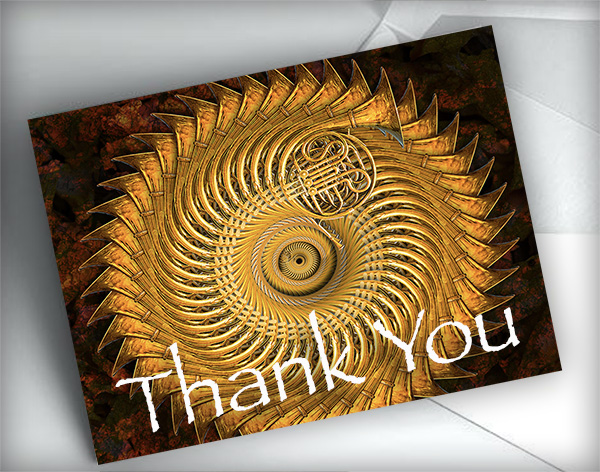
by successfulbob | Guest Post, Marketing Monday, photography education, photography marketing
The Power of a Handwritten Note
Marketing Monday with Skip Cohen
One of the easiest ways to separate yourself from the competition is also one of the most forgotten, a handwritten note. Most of us can barely write a check without making a mistake, simply because we’re so used to typing and texting everything we write.
Over the years I’ve sent hand-written notes and received some great ones. Each one has stood out in a different way and brought me closer to people, even some who I’ve known for many years. There are new friends and old ones, but receiving a handwritten note is such a nice touch to building a stronger network and relationship.
 Use one of your images on the face of the card. Could be the family or subject photographed.
Use one of your images on the face of the card. Could be the family or subject photographed.
(I put my contact info and logo on the back of the card) Graphic by Bob Coates Photography
Here are a few ingredients to make your notecards that much more effective
1) Use one of your own images on the front! NEVER use a store-bought card.
2) On the back of the card share your personal contact information. Centered at the bottom, it should look like the label on a Hallmark card, but your studio or name and contact information, including social media addresses and phone number.
3) Use a nice stock of paper. And, if you make it an odd size, it’ll stand out even more.
4) Take the time to write something personal in appreciation for whatever the person you’re sending it to, did to help you.
So, the next time somebody does something nice for you, or maybe it’s a vendor who takes a little extra time to help you at a convention, remember the power of a hand-written note. There’s little that can top this age-old method of communicating!
 Skip Cohen has been involved in the photographic industry his entire career and previously served as President of Rangefinder/WPPI and earlier, Hasselblad USA. He founded SkipCohenUniversity.com in 2013. Skip is a co-host for “Mind Your Own Business” and “Beyond Technique,” webcasts through Photofocus.com, writes for several publications including Shutter Magazine and is actively involved in several advisory boards for non-profit organizations.
Skip Cohen has been involved in the photographic industry his entire career and previously served as President of Rangefinder/WPPI and earlier, Hasselblad USA. He founded SkipCohenUniversity.com in 2013. Skip is a co-host for “Mind Your Own Business” and “Beyond Technique,” webcasts through Photofocus.com, writes for several publications including Shutter Magazine and is actively involved in several advisory boards for non-profit organizations.

 This lake is in a barrio outside the Forbidden City. The smog aids in coloration at sunset by diffusing the light. Many walk the pathways by the lake. All Photos in this post © Ken MacAdams 2018 All Rights Reserved
This lake is in a barrio outside the Forbidden City. The smog aids in coloration at sunset by diffusing the light. Many walk the pathways by the lake. All Photos in this post © Ken MacAdams 2018 All Rights Reserved The Chinese take their tea seriously – and to be invited to a tea ceremony is a wonderful experience!
The Chinese take their tea seriously – and to be invited to a tea ceremony is a wonderful experience!  weariness came from lugging around his big heavy DSLR. That’s when he started looking at alternatives – and ended up selecting Panasonic Lumix Micro Four Thirds gear.
weariness came from lugging around his big heavy DSLR. That’s when he started looking at alternatives – and ended up selecting Panasonic Lumix Micro Four Thirds gear.



















